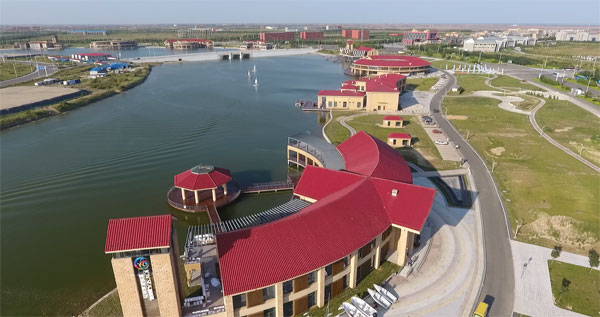Weifang Binhai Economic and Technological Development Zone

Wenchang Lake in Weifang Binhai Economic and Technological Development Zone [Photo/wfbinhai.gov.cn]
Binhai Economic and Technological Development Zone in Weifang, in East China's Shandong province, was founded in August 1995 and upgraded to a national-level development zone under the approval of the State Council in April 2010. It covers a land area of 677 square kilometers and an ocean area of 510 sq km.
The zone, situated in the northern part of Shandong Peninsula and south of the Laizhou Bay in southern Bohai Sea, is an important part of the Bohai Economic Rim and an important hub which links the Yangtze River Delta region and the Beijing-Tianjin-Hebei region.
It also boasts convenient transport, with the Jinan-Qingdao, Rongcheng-Wuhai and Weifang-Rizhao expressways passing through. The Yiyang and Deda-Longyan railways connect the zone with the country's rail network. Weifang Port in the zone also adds to its travel convenience.
The zone enjoys a 69-km-long coastline and a shallow beach area of more than 200,000 mu (13,333.33 hectares). The abundant natural resources, including underground brine, petroleum, natural gas, terrestrial heat and wind power, give the zone huge development potential.
By September 2017, the zone housed more than 1,000 companies involved in more than 1,200 industrial products. The annual output of crude salt and bromine in the zone account for 20 percent and 50 percent of the country's total. It has become China's largest production base for crude salt and bromine.
In 2016, the zone's GDP reached 30.33 billion yuan ($4.40 billion), a year-on-year increase of 8.7 percent. Prime operating revenue of industrial enterprises above designated size totaled 86.98 billion yuan, with a yearly growth rate of 9.8 percent over 2015.
Fixed-asset investment in 2016 was 43.04 billion yuan, increasing by 16 percent over 2015. General public budget revenue reached 3.31 billion yuan, a year-on-year increase of 11.5 percent.
Invest in China Copyright © 2025 China Daily All rights Reserved
京ICP备13028878号-6
 京公网安备 11010502032503号
京公网安备 11010502032503号





